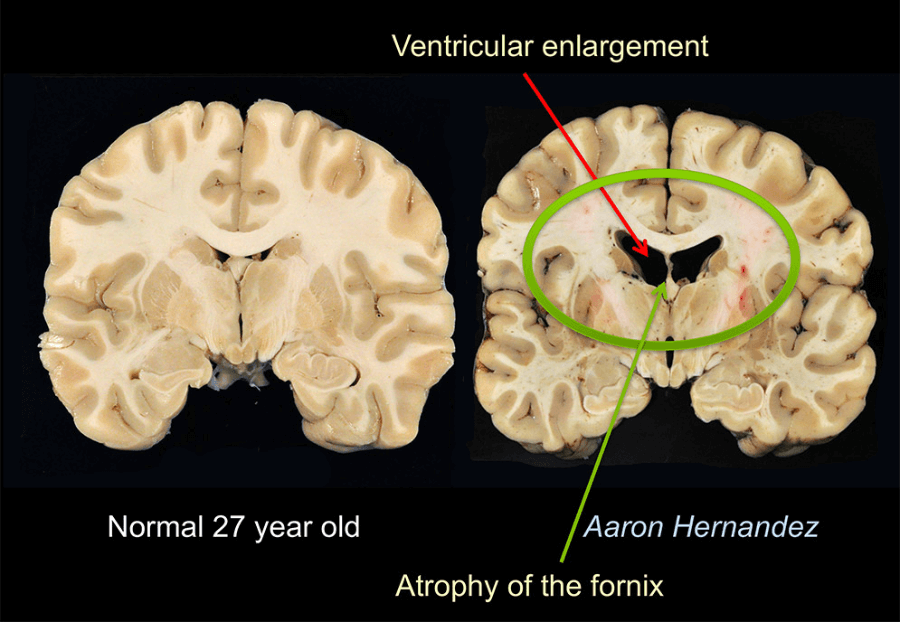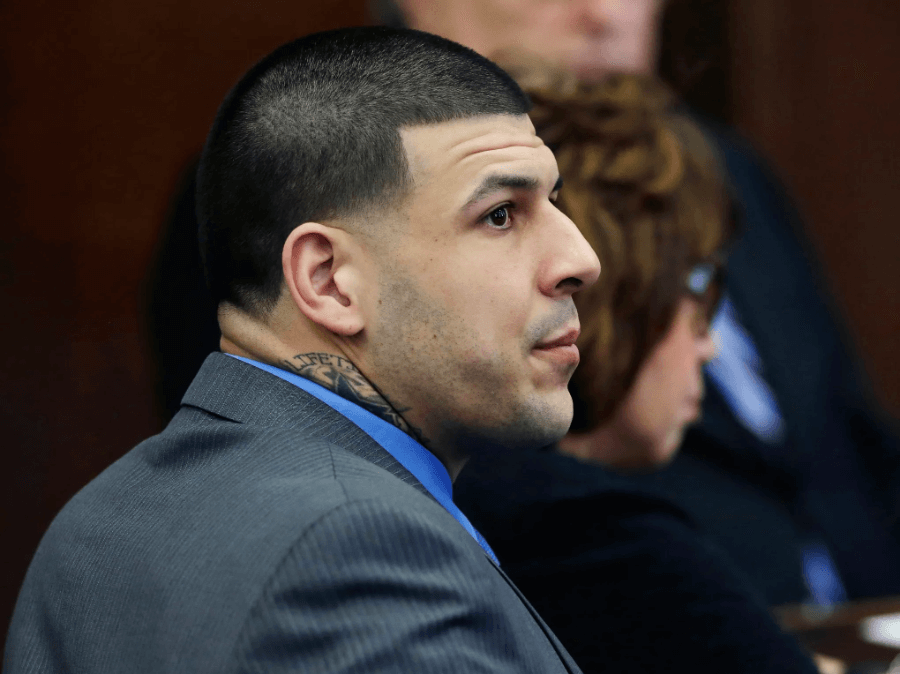📑Table of Contents:
Aaron Hernandez’s story is one of sharp contrasts: a young man with an NFL future, explosive talent, and a life cut short by violence. His tragic downfall—from being convicted of murder to his suicide in prison—captured national attention. But it was after he died in 2017, when his brain was studied, that the true extent of his inner turmoil came to light. The autopsy findings revealed a harrowing truth about Hernandez’s health that may have played a pivotal role in his decisions, behavior, and ultimate fate.
The results of Hernandez’s autopsy weren’t just shocking; they changed how we look at brain injuries, especially in professional athletes. The discovery of chronic traumatic encephalopathy (CTE), a neurodegenerative disease associated with repeated head trauma, raised important questions about football, mental health, and the impact of concussions.

The Tragic Death of Aaron Hernandez
On April 19, 2017, Aaron Hernandez was found dead in his Massachusetts prison cell. He was serving a life sentence for the 2013 murder of Odin Lloyd. Hernandez had been convicted and was awaiting a retrial for another double homicide when he died by suicide. The circumstances surrounding his death, along with his dramatic fall from an NFL star to a convicted murderer, shocked the world.
However, the story didn’t end with his death. It only became more complex.
Just days after Hernandez’s suicide, his family chose to donate his brain to the Boston University CTE Center. The decision was made not only in hopes of understanding the root cause of his behavior but also to contribute to the growing body of research on brain trauma in athletes.
CTE: What It Is and Why It Matters
Chronic traumatic encephalopathy (CTE) is a neurodegenerative disease caused by repeated head trauma. It has been linked to athletes, particularly those involved in contact sports such as football, boxing, and hockey. CTE is characterized by the buildup of tau proteins in the brain, leading to severe memory loss, mood swings, aggressive behavior, and impaired judgment. In its advanced stages, CTE can result in dementia and, tragically, suicide.
While the symptoms can vary, CTE is most commonly associated with individuals who have experienced multiple concussions or sub-concussive hits over their careers. Doctors found this disease in Hernandez’s brain after his death—an unsettling discovery that changed how we view sports brain injuries forever.
In Hernandez’s case, researchers at Boston University’s CTE Center diagnosed him with Stage 3 CTE, one of the most severe forms of the disease. Doctors described his brain damage as similar to what they usually see in people much older than 27. The finding was especially disturbing because Hernandez had suffered from this condition for much of his life, likely contributing to the mental health struggles that accompanied his football career.
Hernandez’s Brain: A Frightening Discovery
The findings from Hernandez’s autopsy were groundbreaking for several reasons. First, his CTE was far more advanced than expected for a person so young. Second, it was a stark reminder of the risks athletes face, particularly in contact sports like football, where repeated head trauma is nearly inevitable.
Researchers found that Hernandez’s brain exhibited severe damage in areas associated with decision-making, behavior regulation, and emotional control. These areas of the brain are responsible for impulses, judgment, and the ability to manage anger or frustration—areas that Hernandez struggled with, as evidenced by his violent tendencies and actions in life.
According to Dr. Ann McKee, the Boston University neuropathologist who led the examination of Hernandez’s brain, the level of damage was consistent with that seen in much older individuals. Hernandez had only played football for a decade before his death, but his brain showed damage that typically occurs in individuals with 20 to 30 years of head trauma exposure.
The diagnosis of Stage 3 CTE in Hernandez’s brain was both a revelation and a devastating reflection of the reality many NFL players face. At the time of his death, Hernandez had exhibited symptoms of the disease that likely contributed to his volatile behavior, including his erratic decisions, mood swings, and aggressive outbursts.
The Link Between CTE and Criminal Behavior

One of the most controversial aspects of Hernandez’s case was the potential link between CTE and his criminal behavior. While there is no definitive proof that CTE caused Hernandez to murder Odin Lloyd, there’s no denying the role it may have played in shaping his personality and actions.
Aaron Hernandez had a history of violent tendencies, including run-ins with the law before the murder of Lloyd. His erratic behavior seemed to escalate over time, and there were moments when he appeared completely detached from the consequences of his actions. His brain injury likely worsened the situation, severely impairing his decision-making and emotional control.
Aaron Hernandez and his case sparked debates within the sports world about the long-term impact of football on mental health. Some speculated that if Hernandez had received proper medical care or if the NFL had taken greater precautions regarding concussions, his fate might have been different. Others argued that CTE and the psychological effects of repeated head trauma could explain a host of issues seen in other athletes, from domestic violence to early-onset dementia.
The NFL and CTE: A Broader Crisis
Aaron Hernandez’s autopsy didn’t just confirm his cause of death—it reignited a national debate over the long-term effects of football on the brain. The revelation that Hernandez had Stage 3 Chronic Traumatic Encephalopathy (CTE) shocked the entire sports world. He was only 27 years old.
The NFL had faced scrutiny over CTE before this incident. The deaths of former players like Junior Seau, who died by suicide in 2012 and had CTE, put the league under fire. His death, like Hernandez’s, raised disturbing questions: How much did brain trauma influence their behavior? And what responsibility does the NFL bear?
The backlash led to a series of lawsuits from former players and their families. In 2013, the NFL reached a $765 million settlement (later expanded) to resolve concussion-related lawsuits, compensating thousands of players suffering from cognitive and neurological issues. However, critics argued that the settlement didn’t go far enough, and cases like Hernandez’s only added to the urgency.
In response, the NFL made several changes to its concussion protocols. These included stricter sideline evaluations, increased penalties for helmet-to-helmet hits, and investment in safer helmet technology. Yet many experts argue that these changes are only scratching the surface of a deeper issue: the inherent violence of the sport.
Aaron Hernandez’s story became a grim example of what can happen when early brain trauma, untreated mental health issues, and a culture of silence collide. His case pushed the conversation further, forcing fans, families, and the NFL itself to confront the lasting damage the game can inflict, both on and off the field.
Legal and Cultural Implications
Hernandez’s diagnosis brought national attention to the issue of CTE and its devastating effects. It highlighted how contact sports, particularly football, fail to adequately protect players from the risks of concussion and repeated head injuries. While the NFL has taken steps to improve player safety by introducing concussion protocols and reducing contact in practice, many argue these measures don’t go far enough.
After Hernandez’s diagnosis, his family sued the NFL, accusing the league of contributing to the damage from head injuries. The lawsuit was part of a larger movement by former players and their families who were seeking justice for the long-term health effects of playing football. Though Hernandez’s case was unique in its severity, it wasn’t an isolated incident. Many former players, including NFL legends like Junior Seau and Mike Webster, received CTE diagnoses after their deaths.
Hernandez’s case has become a central point in the ongoing conversation about CTE in sports. His brain injury provides stark evidence of the risks athletes face, and it underscores the need for more awareness, prevention, and research to protect future generations of players.
Aftermath and Legacy
Aaron Hernandez’s life and his tragic death continue to raise important questions about mental health, brain injuries, and the price of fame. The public reeled from his fall from NFL stardom and brutal crimes, then faced the sobering truth of his brain condition. His case has not only influenced the conversation about CTE but also shone a light on the often-hidden dangers of contact sports.
For Hernandez’s family, his diagnosis was both a tragic confirmation and a painful reminder of the consequences of head trauma. For the rest of us, it’s a wake-up call. As the world continues to wrestle with the ethics of contact sports, Hernandez’s story will undoubtedly be a crucial point in future discussions about player health and safety.

Final Thoughts
The autopsy of Aaron Hernandez’s brain revealed the devastating toll of CTE, offering a glimpse into the tragic decline of a once-promising NFL star. His story is a reminder that the consequences of repeated head trauma are not just physical—they are mental, emotional, and far-reaching. While his crimes will forever mark his legacy, his diagnosis has helped shape the future of how we think about sports, health, and the price of fame.
The conversation around CTE is far from over, and Hernandez’s case will likely remain a key reference point in future debates. In the end, his life—and his death—serve as an important lesson on the importance of safeguarding both the body and mind.





